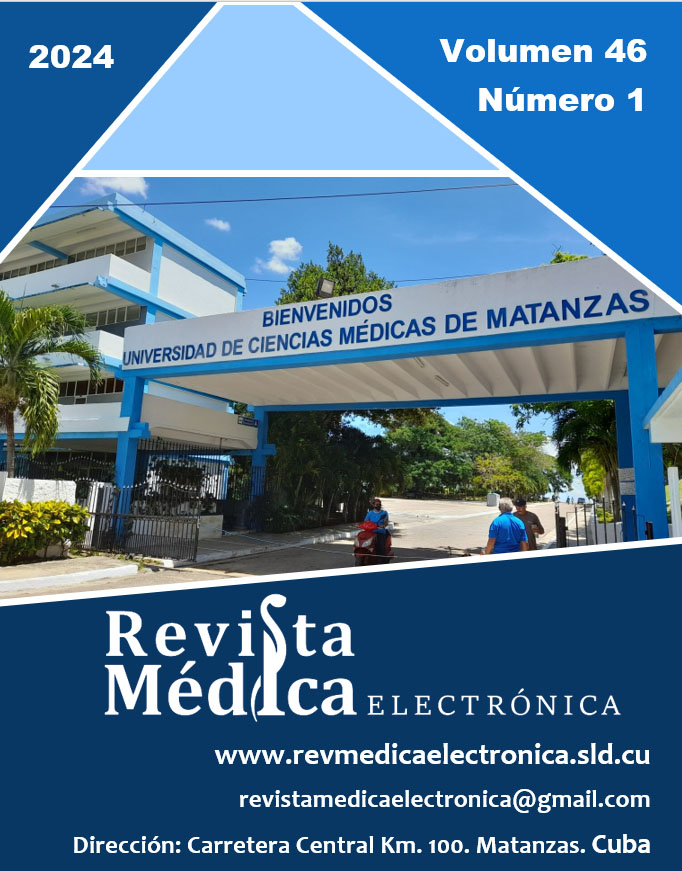Nursing knowledge in severe traumatic brain injury and intracranial pressure monitoring
Keywords:
nursing knowledge, intracranial pressure, severe traumatic brain injuryAbstract
Introduction: Severe traumatic brain injury is an important cause of mortality and disability worldwide and the most common cause is blunt trauma; some consider it a “silent epidemic.” The monitoring of intracranial pressure, its adequate recording, and the correct interpretation of the values allow early diagnosis and treatment, without reaching intracranial hypertension.
Objective: To identify the level of nursing knowledge on severe traumatic brain injury and intracranial pressure monitoring.
Methods: An observational, descriptive and cross-sectional analytical study of technological development was carried out in the Intensive Care Unit of the Clinical Surgical University Hospital Comandante Faustino Pérez Hernandez, in the period from January 2022 to July 2023. The universe was made up of the 62 nurses to whom the inclusion criteria (the willingness to participate in the study) and exclusion criteria (temporary stay nurses) were applied. The data collection form and a questionnaire were used.
Results: The highest percentage of the nurses studied provided care at the bedside; among the years of experiences prevailed from 0-1 year and ages were 20-29 years. The application of the questionnaire explored the level of knowledge at the Low level. In the diagnosis stage, the need to strengthen nursing knowledge on the actions of patient with severe traumatic brain injury and intracranial pressure monitoring was confirmed.
Conclusions: It was diagnosed the need to strengthen knowledge to cope with care for patients with traumatic brain injury.
Downloads
References
2. Munakomi S, Das JM. Intracranial Pressure Monitoring. 2023 feb12. StatPearls [Internet]. 2024 [citado 18/01/2023]. Disponible en: https://pubmed.ncbi.nlm.nih.gov/31194438/
3. López Caballero A, Dominguez Pérez MA. Terapia Intensiva. 3ª ed. La Habana: Editorial Ciencias Médicas; 2020.
4. Vilela Pata MA. Manejo Clínico en pacientes con Presión Intracraneal post Punción lumbar. Dom Cien [Internet]. 2022 [citado 18/03/2023];8(1):1250-65. Disponible en: https://dialnet.unirioja.es/descarga/articulo/8548173.pdf
5. Ariaka H, Kiryabwire J, Hussein S, et al. A Comparison of the Predictive Value of the Glasgow Coma Scale and the Kampala Trauma Score for Mortality and Length of Hospital Stay in Head Injury Patients at a Tertiary Hospital in Uganda: A Diagnostic Prospective Study. Surg Res Pract [Internet]. 2020 [citado 18/03/2023];2020:1-9. Disponible en: https://www.hindawi.com/journals/srp/2020/1362741/
6. Herdenson V, Alexander JE, Wertman De Meester D. Definición de enfermería. En: Marriner TA, Raile Alligood M. Modelos y teorías de enfermería. 4ª ed. Madrid: Harcourt; 2000.
7. Colquehuanca Macopachi B. Competencias cognitivas y técnicas del profesional de enfermería en el proceso de destete en paciente con ventilación mecánica, Unidad de Terapia Intensiva, Hospital Petrolero de Obrajes, Gestión 2019 [tesis en Internet]. La Paz: Universidad Mayor de San Andrés; 2019 [citado 21/08/2023]. Disponible en: https://repositorio.umsa.bo/handle/123456789/24067
8. Espinosa Aguilar A, Gilbert Lamadrid MP, Orisa Saavedra M. El desempeño de los profesionales de Enfermería. Rev Cubana Enfermer [Internet]. 2016 [citado 21/08/2023];32(1). Disponible en: https://www.researchgate.net/publication/317514184_El_desempeno_de_los_profesionales_de_Enfermeria
9. Ferrer Arnedo C. Tipos de liderazgo en enfermería [Internet]. Vizcaya: Salusplay; 2019 [citado 25/05/2022]. Disponible en: https://www.salusplay.com/blog/tipos-liderazgo-enfermeria/
10. Zabalegui A. A propósito del liderazgo en Enfermería. Nursing. 2018;35(1). DOI: 10.1016/j.nursi.2018.02.001.
11. Hernández Pérez R, Hernández Núñez A, Molina Borges M, et al. Evaluación del desempeño profesional de enfermeros asistenciales bajo la teoría de Patricia Benner. Rev Cubana Enferm [Internet]. 2020 [citado 16/03/2024];36(4). Disponible en http://scielo.sld.cu/scielo.php?script=sci_arttext&pid=S0864-03192020000400013
12. Quintana Atencio D, Tarqui Maman C. Desempeño laboral del profesional de enfermería en un hospital de la seguridad social del Callao - Perú. Arch Med [Internet]. 2019 [citado 16/03/2024];20(1):123-32. Disponible en: https://www.redalyc.org/journal/2738/273862538013/
13. Bautista Martínez C, Medina Reyes M, Martínez Martínez J. Evaluación de nivel de conocimientos sobre cuidado para pacientes neurocríticos en personal de enfermería. Rev Enferm Neurol [Internet]. 2022 [citado 16/03/2024];21(3):235-47. Disponible en: https://docs.bvsalud.org/biblioref/2023/05/1428457/articulo-5-evaluacion.pdf
14. Martínez Urroz S. Cuidados de enfermería al paciente con traumatismo craneoencefálico grave en UCI [tesis en Internet]. Navarra: Universidad Pública de Navarra; 2022 [citado 21/08/2023]. Disponible en: https://academica-e.unavarra.es/bitstream/handle/2454/43069/PDF_Mart%C3%ADnezUrrozSaraTFG.pdf?sequence=1&isAllowed=y
15. Rodríguez Seguin HD. Conocimiento y cuidado enfermero en pacientes con traumatismos encefálicos craneano en el servicio de emergencia del Hospital Cayetano Heredia, 2022 [tesis en Internet] Lima: Universidad Norbert Wiener; 2022 [citado 21/08/2023]. Disponible en: https://repositorio.uwiener.edu.pe/handle/20.500.13053/7478
16. Val Jordán E, Fuentes Esteban D, Casado Pellejero J, et al. Actualización en el manejo de la hipertensión intracraneal tras un traumatismo craneoencefálico. Sanid Mil [Internet]. 2023 [citado 29/05/2024];79(1):52-60. Disponible en: http://scielo.isciii.es/scielo.php?script=sci_arttext&pid=S1887-85712023000100012&Ing=es
Downloads
Published
How to Cite
Issue
Section
License
All content published in this journal is Open Access, distributed under the terms of the CC BY-NC 4.0 License.
It allows:
- Copy and redistribute published material in any medium or format.
- Adapt the content.
This will be done under the following terms:
- Attribute the authors' credits and indicate whether changes were made, in which case it must be in a reasonable way.
- Non-commercial use.
- Recognize the journal where it is published.
The copyrights of each article are maintained, without restrictions.






